The NVIDIA GeForce GTX 1080 Ti Founder's Edition Review: Bigger Pascal for Better Performance
by Ryan Smith on March 9, 2017 9:00 AM ESTGrand Theft Auto V
The latest edition of Rockstar’s venerable series of open world action games, Grand Theft Auto V was originally released to the last-gen consoles back in 2013. However thanks to a rather significant facelift for the current-gen consoles and PCs, along with the ability to greatly turn up rendering distances and add other features like MSAA and more realistic shadows, the end result is a game that is still among the most stressful of our benchmarks when all of its features are turned up. Furthermore, in a move rather uncharacteristic of most open world action games, Grand Theft Auto also includes a very comprehensive benchmark mode, giving us a great chance to look into the performance of an open world action game.
On a quick note about settings, as Grand Theft Auto V doesn't have pre-defined settings tiers, I want to quickly note what settings we're using. For "Very High" quality we have all of the primary graphics settings turned up to their highest setting, with the exception of grass, which is at its own very high setting. Meanwhile 4x MSAA is enabled for direct views and reflections. This setting also involves turning on some of the advanced redering features - the game's long shadows, high resolution shadows, and high definition flight streaming - but it not increasing the view distance any further.
Otherwise for "High" quality we take the same basic settings but turn off all MSAA, which significantly reduces the GPU rendering and VRAM requirements.
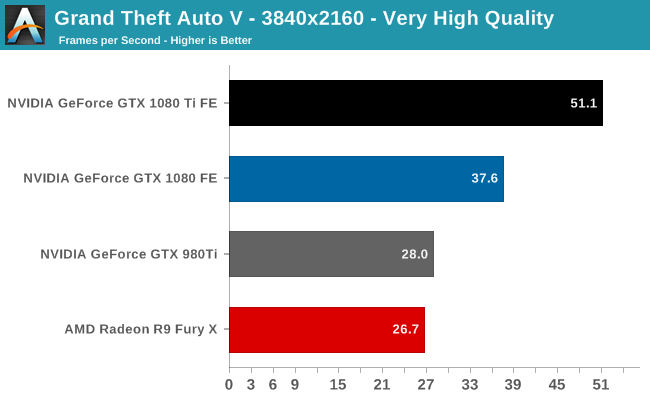
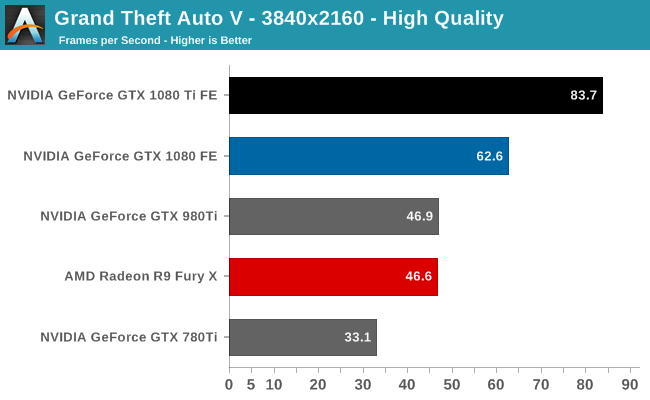
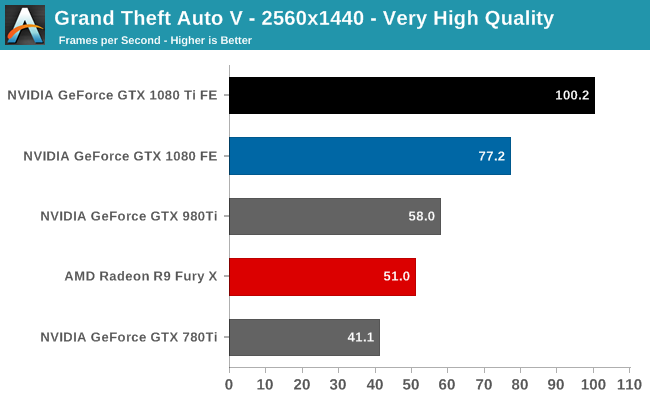
Grand Theft Auto V is another game where the GTX 1080 Ti won’t quite reach 60fps at 4K with all the bells & whistles, but it gets close in doing so. Given that this was originally a console game that ran at 30fps, 51.1 should make a lot of people reasonably satisfied, but there’s always room for improvement.
Relative to the GTX 980 Ti, this is actually the GTX 1080 Ti’s best game; it picks up a better-than-average 83% in performance. I suspect that GTAV is an outlier that is especially memory bandwidth sensitive, benefitting from the combination of a raw 44% increase in memory bandwidth from the previous generation, and NVIDIA’s improved memory compression technology on the Pascal architecture.
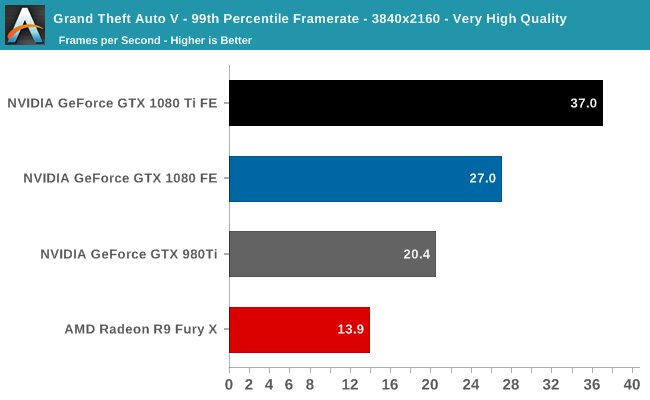
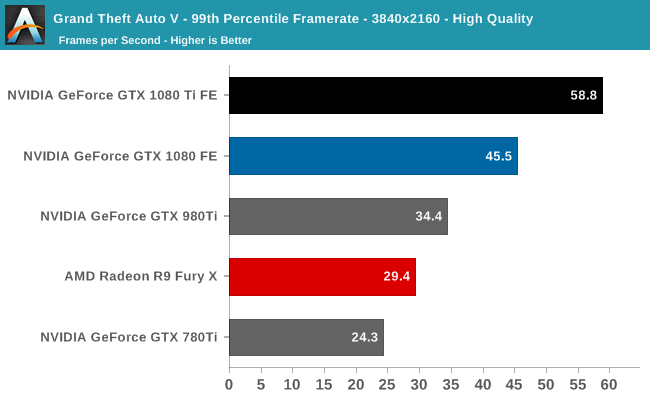

Looking at the minimum framerates, the story is much the same. For gamers looking for high minimum framerates, the GTX 1080 Ti is the first card that can deliver better than 30fps at the 99th percentile. So while it can’t average 60fps, it also will never drop to the 30fps rate that its console counterparts are capped at in the first place.










161 Comments
View All Comments
close - Monday, March 13, 2017 - link
I was talking about optimizing Nvidia's libraries. When you're using an SDK to develop a game you'er relying a lot on that SDK. And if that's exclusively optimized for one GPU/driver combination you're not going to develop an alternate engine that's also optimized for a completely different GPU/driver. And there's a limit to how much you can optimize for AMD when you're building a game using Nvidia SDK.Yes, the developer could go ahead and ignore any SDK out there (AMD or Nvidia) just so they're not lazy but that would only bring worse results equally spread across all types of GPUs, and longer development times (with the associated higher costs).
You have the documentation here:
https://docs.nvidia.com/gameworks/content/gamework...
AMD offers the same services technically but why would developers go for it? They're optimizing their game for just 25% of the market. Only now is AMD starting to push with the Bethesda partnership.
So to summarize:
-You cannot touch Nvidia's *libraries and code* to optimize them for AMD
-You are allowed to optimize your game for AMD without losing any kind of support from Nvidia but when you're basing it on Nvidia's SDK there's only so much you can do
-AMD doesn't really support developers much with this since optimizing a game based on Nvidia's SDK seems to be too much effort even for them, and AMD would rather have developers using the AMD libraries but...
-Developers don't really want to put in triple the effort to optimize for AMD also when they have only 20% market share compared to Nvidia's 80% (discrete GPUs)
-None of this is illegal, it's "just business" and the incentive for developers is already there: Nvidia has the better cards so people go for them, it's logical that developers will follow
eddman - Monday, March 13, 2017 - link
Again, most of those gameworks effects are CPU only. It does NOT matter at all what GPU you have.As for GPU-bound gameworks, they are limited to just a few in-game effects that can be DISABLED in the options menu.
The main code of the game is not gameworks related and the developer can optimize it for AMD. Is it clear now?
Sure, it sucks that GPU-bound gameworks effects cannot be optimized for AMD and I don't like it either, but they are limited to only a few cosmetic effects that do not have any effect on the main game.
eddman - Monday, March 13, 2017 - link
Not to mention that a lot of gameworks game do not use any GPU-bound effects at all. Only CPU.eddman - Monday, March 13, 2017 - link
Just one example: http://www.geforce.com/whats-new/articles/war-thun...Look for the word "CPU" in the article.
Meteor2 - Tuesday, March 14, 2017 - link
Get a room you two!MrSpadge - Thursday, March 9, 2017 - link
AMD demonstrated they "cache thing" (which seems to be tile based rendering, as in Maxwell and Pascal) to result in a 50% performance increase. So 20% IPC might be far too conservative. I wouldn't bet on a 50% clock speed increase, though. nVidia designed Pascal for high clocks, it's not just the process. AMD seems to intend the same, but can they get it similarly well? If so I'm inclined to ask "why did it take you so long"?FalcomPSX - Thursday, March 9, 2017 - link
I look forward to vega and seeing how much performance it brings, and i really hope it does end up giving performance around a 1080 level for typically lower and more reasonable AMD pricing, but honestly, i expect it to probably come close to but not quite match a 1070 in dx11, surpass it in dx12, and at a much lower price.Midwayman - Thursday, March 9, 2017 - link
Even if its just 2 polaris chips of performance you're past 1070 level. I think conservative is 1080 @ $400-450. Not that there won't be a cut down part at 1070 level, but I'd be really surprised if that is the full die version.Meteor2 - Tuesday, March 14, 2017 - link
I think that sometimes Volta is over-looked. Whatever Vega brings, I feel Volta is going to top it.AMD is catching up with Intel and Nvidia, but outside of mainstream GPUs and HEDT CPUs, they've not done it yet.
Meteor2 - Tuesday, March 14, 2017 - link
Mind you Volta is only coming to Tesla this year, and not consumer until next year. Do AMD should have a competitive full stack for a year. Good times!